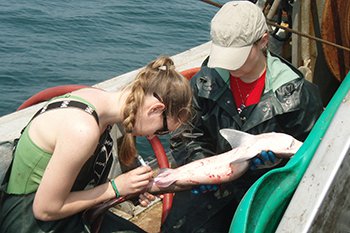It seems that spiny dogfish are on the tip of everybody’s tongue, but not literally. That’s why some fishermen, scientists, policy makers, and consumers are hoping the ‘dogs become a more commercially fished species in New England, and that the species ends up in the mouths of consumers all over the world.
In 2014, NOAA awarded the University of New England $245,000 grant to study dogfish and ways to market the species. UNE photo.“Fish the hell out of them, let the ‘dogs in! Really. They are like a Biblical plague of locusts, that’s what they are. They are everywhere, they are eating everything–it’s changing everything. The Gulf of Maine used to be dominated by groundfish and now it's dominated by spiny dogfish sharks,” says Barry Costa-Pierce, Director of the Marine Science Center at the University of New England in Portland, Maine.
“This requires exaggeration because not many people have seen this before,” adds Costa-Pierce. “The oceanographers have got it right–the Gulf of Maine is the most rapidly warming part of the ocean in the world.” Costa-Pierce gave a lecture this spring during which he spoke about new opportunities for Maine’s ocean economy as a result of global climate change, including the potential for a viable dogfish fishery in the Gulf of Maine. Maine, says Costa-Pierce, is becoming “the front door to the Arctic” and new shipping lines could make it feasible to transport spiny dogfish into new markets like Iceland, and possibly beyond.
James Sulikowski, Professor of Marine Science at UNE, published a report two years ago revealing how underestimated the standing stock biomass is. “The population is not overfished, the standing stock biomass is 371 million pounds throughout their range, according to the latest 2015 assessment,” says Sulikowski. ‘Dogs are not only a source of protein, but a fertilizer, meat, flesh, and lobster bait. “Everything can be used, and we don't use all of our quota since it’s underdeveloped,” adds Sulikowski. “To be sure we do the ecosystem and species right, we need more collaborative and larger scale research projects to ensure we can use this resource for the long haul.”
New Bedford is currently the center of the dogfish processing industry, and the UK’s fish and chips market (where dogfish are called rock salmon) is strong. In Germany, the bellies and backs are highly desired. But, some people have their eyes on China, a potential emerging market.
For the last few years, commercial fishermen Doug Feeney, of Chatham, MA has been focused on dogfish. He attended a large seafood expo in Qingdao, China last year in an effort to spark the world market for dogfish.
“They want American seafood that is not polluted, and they want to be able to trace their seafood and where it is coming from, which we have. I was shooting for them to take the whole dogfish and process it,” says Feeney “My whole movement is to do it for dogfish up and down the coast. I’m doing it for the fishermen. There is nothing else out there for us. We’re stuck with skates and groundfish. Instead of treating [dogfish] like crap, like we always have, this is what we have.”
Whether dogfish end up on more plates in the US, or China is unknown. But one thing, according to Feeney, is certain: the need to build new markets. “We need to rethink it. We only have so many markets–and it’s Europe right now,” says Feeney. “We have three processors, but we don’t have the markets. So we’ll go slow and steady and build new markets.”







